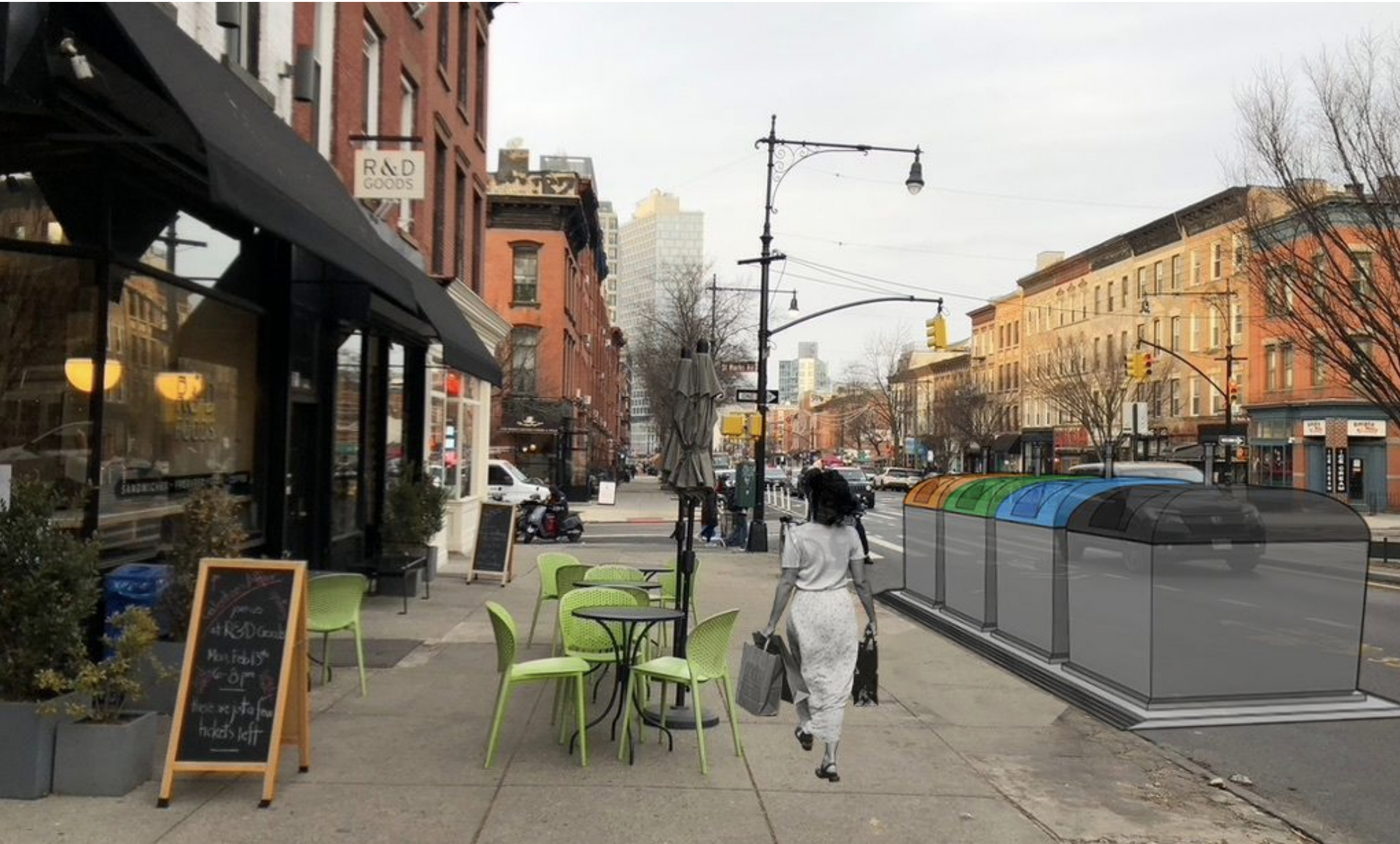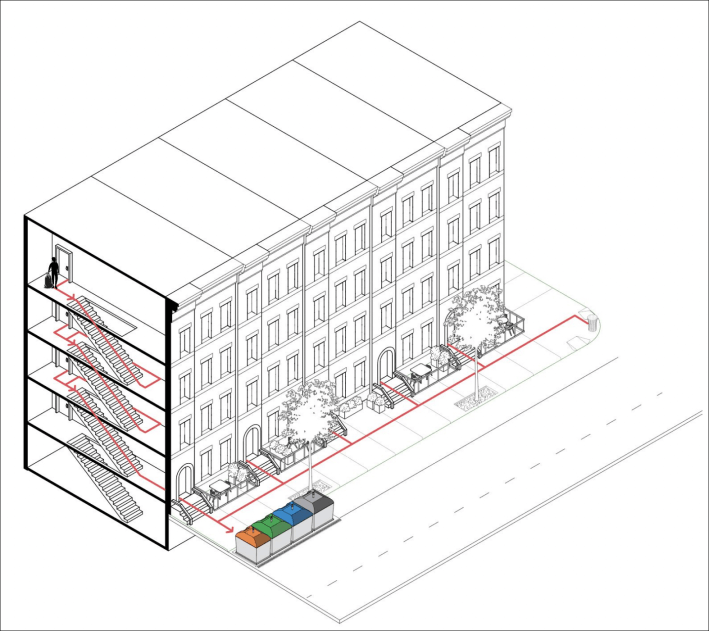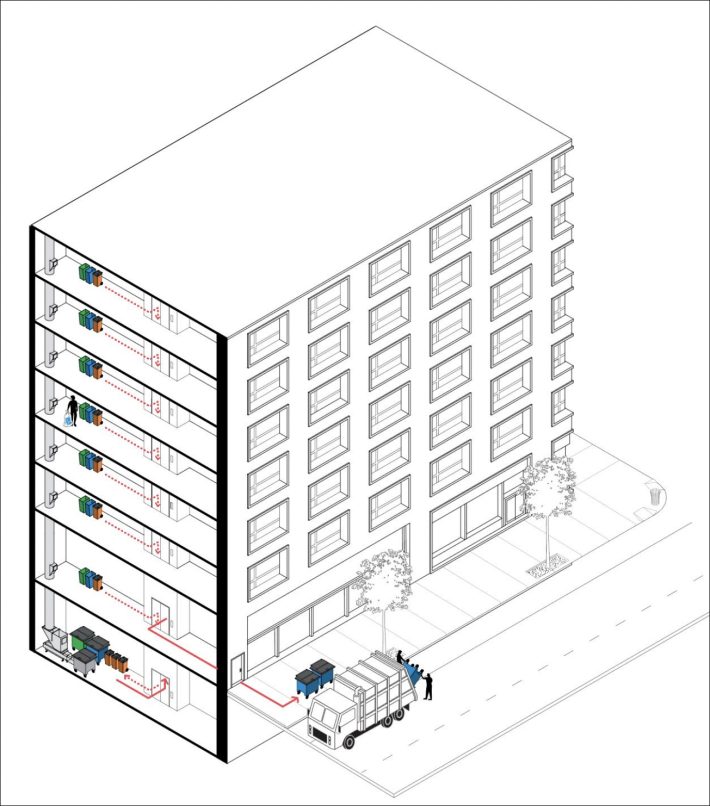Vanderbilt Avenue Open Street Could Be Model for Trash Containerization: Report
1:46 PM EDT on March 28, 2023

Note the lack of black bags. Rendering: Center for Zero Waste Design
The Vanderbilt Avenue open street in Brooklyn could become a blueprint for how the city can finally containerize its trash for collection, a new analysis reveals.
Experts found that containers could replace the mounds of trash and free up sidewalk space on the stretch between Atlantic Avenue and Park Place that has become popular car-free corridor during the warmer months.
The half-dozen blocks in Prospect Heights have a mix of residential and commercial properties in both lower and higher-rise buildings, making them an ideal test case for many parts of the city, according to Clare Miflin, an architect and the founder of Center for Zero Waste Design, the organization behind the report.
"It’s a perfect sample because there’s so much of the city that’s like that," Miflin told Streetsblog.
As other cities like Paris and Barcelona have long figured out, trash can go in stationary curbside containers or wheeled bins — but the city would need new or modified trucks to pick up these boxes, and waste officials might have to increase or spread out collection schedules.
But the changes could virtually eliminate the space that garbage occupies on the sidewalk — as much as 25 percent — and in the public mind, as one participant in the report said.
"Doing this made us all realize like, ‘Wow, we have handed over a lot of public space to cars — and to trash as well," said Saskia Haegens, the vice chair of the Prospect Heights Neighborhood Development Council, the all-volunteer group that runs the open streets on Vanderbilt and Underhill avenues and also worked on the study.
How it would work
On streets with three- and four-story walk-ups, residents could drop their trash in sets of curbside containers roughly the size of common wheeled Dumpsters. Most blocks like that would just need one row of bins on each side of the street taking up a little more than one parking space, according to the report.

Each pod would have four containers for trash, recycling, and organic waste, either in 1.4-cubic yard wheeled bins inside enclosures, or stationary containers with up to three cubic yards of capacity.
DSNY could collect the wheel bins by adding lifts to the back of its existing fleet of rear loaders, but would have to buy new trucks to hoist the larger stationary boxes.
Outfitting DSNY trucks with lift equipment for the wheeled bins would cost about $12,000 per vehicle, the report estimates.
The agency has more than 2,100 rear-loader trucks and another roughly 600 dual-bin trucks — meaning a cost of $32 million.
The city is currently piloting containers on one block in Hells Kitchen, to which only building supers and DSNY have access, but New York's Strongest still have to haul bags out of the enclosures by hand.
Those boxes on W. 45th Street are just under half a cubic yard big, and there are nine of them per row shared by several buildings.
Sanitation Commissioner Jessica Tisch recently said that approach was not scalable citywide, because it drained resources and bags still ended up outside the bins — even when the receptacles weren't full. It's also not how it's done in Europe.
For the stationary containers DSNY would have to use trucks that can hoist them, an approach the city's public housing authority plans to pilot with a contract slated to go out this spring.
The open street's one high rise, a 17-story apartment building between Dean and Pacific Streets, produces too much trash to hold in stationary containers for several days.
Instead, the researchers propose building staff set out wheeled containers at a designated section of the curb, for DSNY to pick up over a spread out collection schedule.

The agency could run the same number of truck trips as it does for current collections, but divide recycling over several days instead collecting cardboard and other recyclables together with trash on Mondays.
Residential waste currently fills up 25 percent of the sidewalk space on that block, while commercial trash covers 20 percent of the pedestrian space.
The proposals would have containers would take up 22 percent of the curb length in the roadway and only 1.5 percent of the sidewalk.
Containerization would be especially welcome for residents who live above commercial businesses that don't have space to leave their garbage in bins outside their buildings. DSNY recently gave locals a taste of containerized trash when it installed some drop-off smart composting bins.
"It’s really convenient to go downstairs and put a bag full of compost in the bin," said Emily Yue, who for two years has lived above a restaurant on Vanderbilt. "It would be visually nicer and probably cleaner to have the trash in a container versus on the ground, where it can fall out and blow in the wind."
Businesses could also use wheeled bins for pickup by private carters, which collect the city's commercial waste. That would be helped by the Adams administration moving ahead with the stalled commercial waste zone reforms so businesses dividing the city into different areas for waste hauling companies.
The Department of Transportation is currently redesigning the road, adding painted curb extensions, daylighting corners, and adding loading zones, and DOT should work with DSNY to allocate street space to garbage pickup, the report argues.
"Might as well roll other initiatives that we know people have been asking for for years, roll all of that into one," said Haegens.
Any overhaul of New York's trash collection system will require action from the Department of Sanitation, which plans to release its own report on citywide containerization this spring after hiring consultants McKinsey for nearly $4 million to study ways of shaving Big Apple's notorious five o'clock shadow of rubbish.
Sanitation spokesman Vincent Gragnani said the agency shares the goal of the report.
"We are looking at containerization on a citywide level and expect to have a report this spring. We look forward to ongoing dialogue with stakeholders once we have released our report," he said.
Kevin Duggan joined Streetsblog in October, 2022, after covering transportation for amNY. Duggan has been covering New York since about 2017 after getting his masters in journalism from Dublin City University in Ireland. After some freelancing, he landed a job with Vince DiMiceli’s Brooklyn Paper, where he covered southern Brooklyn neighborhoods and, later, Brownstone Brooklyn. He’s on Twitter at @kduggan16. And his email address is kevin@streetsblog.org.
Read More:
Stay in touch
Sign up for our free newsletter
More from Streetsblog New York City
New York City to Install 500 Secure Bike Parking Hubs In The Next Five Years: Sources
Your bike may finally get a roof over its head.
Adams Backs Lower Speed Limits, Calls Crashes ‘Accidents’
The mayor wants New York City drivers to "slow down," but it's not clear yet how many streets will get lower speed limits.
Wednesday’s Headlines: Trump Posts About Congestion Pricing Edition
Donald Trump comments on congestion pricing — no surprise, he's against it. Plus more news.
DOT Aims to Build First Ave. Tunnel Bike Lane Before September’s UN General Assembly
DOT hopes to have the concrete-protect tunnel bike lane installed this summer, but its exact plans are still in development.
Waste Reforms Could Require Data on Crashes, Dangerous Driving
The proposal affects at least one trucking company with a deadly driving record.




